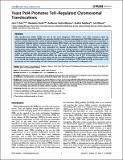Por favor, use este identificador para citar o enlazar a este item:
http://hdl.handle.net/10261/99629COMPARTIR / EXPORTAR:
 SHARE SHARE
 CORE
BASE CORE
BASE
|
|
| Visualizar otros formatos: MARC | Dublin Core | RDF | ORE | MODS | METS | DIDL | DATACITE | |

| Título: | Yeast Pol4 Promotes Tel1-Regulated Chromosomal Translocations |
Autor: | Ruiz, José F. CSIC ORCID; Pardo, Benjamín CSIC ORCID; Sastre-Moreno, Guillermo; Aguilera, Andrés CSIC ORCID; Blanco Dávila, Luis | Fecha de publicación: | 2013 | Editor: | Public Library of Science | Citación: | PLoS Genetics 9 (2013) | Resumen: | DNA double-strand breaks (DSBs) are one of the most dangerous DNA lesions, since their erroneous repair by nonhomologous end-joining (NHEJ) can generate harmful chromosomal rearrangements. PolX DNA polymerases are well suited to extend DSB ends that cannot be directly ligated due to their particular ability to bind to and insert nucleotides at the imperfect template-primer structures formed during NHEJ. Herein, we have devised genetic assays in yeast to induce simultaneous DSBs in different chromosomes in vivo. The repair of these breaks in trans could result in reciprocal chromosomal translocations that were dependent on classical Ku-dependent NHEJ. End-joining events leading to translocations were mainly based on the formation of short base pairing between 3′-overhanging DNA ends coupled to gap-filling DNA synthesis. A major proportion of these events were specifically dependent on yeast DNA polymerase Pol4 activity. In addition, we have discovered that Pol4-Thr540 amino acid residue can be phosphorylated by Tel1/ATM kinase, which could modulate Pol4 activity during NHEJ. Our data suggest that the role of Tel1 in preventing break-induced chromosomal translocations can, to some extent, be due to its stimulating effect on gap-filling activity of Pol4 to repair DSBs in cis. Overall, this work provides further insight to the molecular mechanisms of DSB repair by NHEJ and presents a new perspective to the understanding of how chromosomal translocations are formed in eukaryotic cells. © 2013 Ruiz et al. | URI: | http://hdl.handle.net/10261/99629 | DOI: | 10.1371/journal.pgen.1003656 | Identificadores: | doi: 10.1371/journal.pgen.1003656 issn: 1553-7390 |
| Aparece en las colecciones: | (CBM) Artículos |
Ficheros en este ítem:
| Fichero | Descripción | Tamaño | Formato | |
|---|---|---|---|---|
| L_Blanco_Plos_One.pdf | 1,51 MB | Adobe PDF |  Visualizar/Abrir |
CORE Recommender
PubMed Central
Citations
7
checked on 02-abr-2024
SCOPUSTM
Citations
7
checked on 19-abr-2024
WEB OF SCIENCETM
Citations
10
checked on 25-feb-2024
Page view(s)
278
checked on 19-abr-2024
Download(s)
244
checked on 19-abr-2024
Google ScholarTM
Check
Altmetric
Altmetric
Artículos relacionados:
NOTA: Los ítems de Digital.CSIC están protegidos por copyright, con todos los derechos reservados, a menos que se indique lo contrario.
